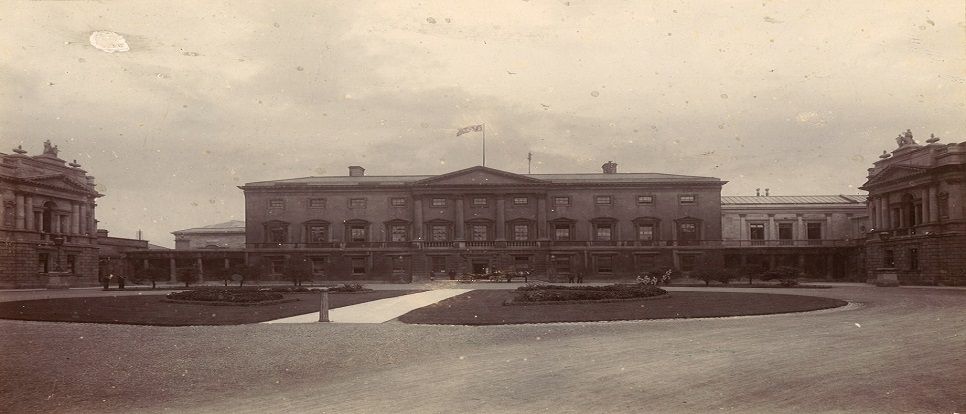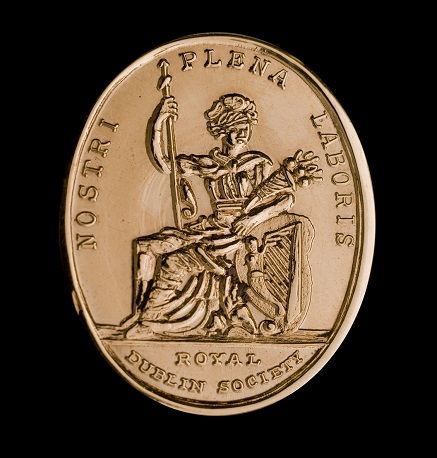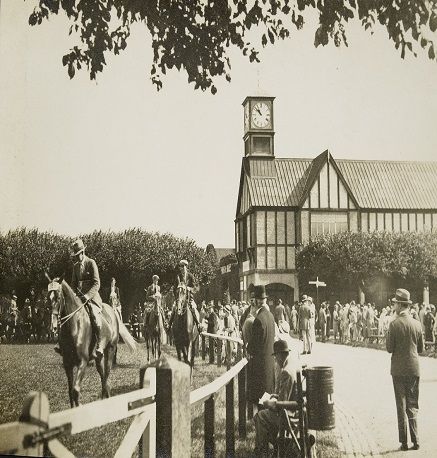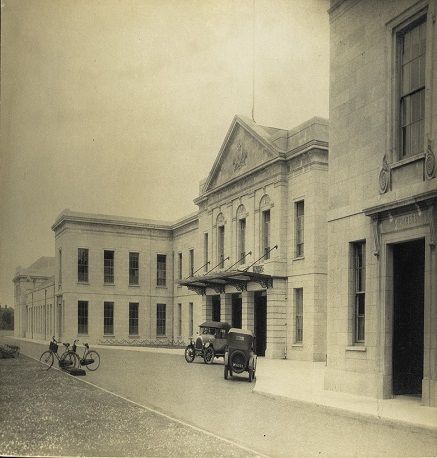Our History
On 25 June 1731, a group of patriots and visionaries met for the first time and formed what is now called the RDS. They were radical thinkers who believed in the power of ideas, and of turning these ideas into action.

Their mission was to put ideas into action that would transform Ireland by creating a thriving, vibrant culture and economy.
For almost 300 years the RDS has responded to the needs and priorities of Ireland, addressing gaps in the development of our culture and economy that have shaped the country. By 1734, the RDS had organised the planting of 55 million trees to make better use of the land as well as produce timber for future building and development. By 1877, the Society had created or nurtured four major cultural institutions to support artists and showcase the best of Irish arts and culture: The National Museum of Ireland, The National Library, The National Gallery and NCAD. Recognising the potential of the Irish horse, the motorcar of the time, the RDS devised a Horse Show in the 1860s. The Show continues to promote best practice in breeding and to showcase the best sport horses in the country.
Many committed visionary people have sat around the RDS table and have made a huge impact on Irish life; Edward Stanley, who had the idea of an event to showcase Irish manufacturing with an aim to improve employment opportunities in Ireland; Walter Wade who was the brainchild and creator of our National Botanical Gardens; William Wiley and Edward Bohane who were pivotal in building the impact of the Dublin Horse Show and Spring Show to showcase best practice to farmers around Ireland and raise the profile of Irish animals in foreign markets. The list of RDS Members that have contributed, that have given their energy to the mission of the RDS is long. And in doing so, they have been part of a collective effort that has given back to Ireland over generations.



Thomas Prior, and the founding Members who gathered around him, believed from the very beginning that having a base to nurture ideas and where Members can research, discuss and make plans, was vital to the level of impact they could achieve. Wherever they landed, the RDS Members have created an inspiring, energetic, visionary base. From rooms in Trinity College Dublin in 1731, to Leinster House in 1814, which they handed over to the Irish Government in 1923, and finally to Ballsbridge. In Ballsbridge different ideas had a place to grow. Events and discussion could happen in beautiful surrounds, a concert hall for music, a library to preserve historic books and documents, iconic halls to showcase industry and a fine sporting arena that is already iconic within European rugby and home to one of the best equestrian events in the globe.
Throughout its history, the RDS has brought momentum and scale to major issues that underpin Ireland’s culture and economy and it continues to do so today.
-
Agriculture has been a persistent theme of the RDS since its foundation. In its first eighteen months the Society reprinted or published up-to-date material on the latest agricultural innovations, such as Jethro Tull's book on Tillage, a paper 'on improvement of flax by changing the soil' and 'a new method of draining marshy and boggy lands'. The Society followed this in year to come with further publications on grass cultivation, saffron planting, drainage, management of hops, bee management, wool production and tillage. They also held demonstrations on how to use a newly designed farm machinery.
Forestry was encouraged from an equally early stage with records of the Society showing that premiums were increasingly awarded for afforestation from 1742 onwards. Between 1766 and 1806 over 55 million trees were planted in Ireland on foot of the Society's initiatives.
The genesis of Dublin's Botanic Gardens can be found in the minute books of the Dublin Society as far back as 1732. From this time onwards, the Dublin Society sporadically leased land around the city to conduct agricultural and botanic experiments and initiatives. In 1790, enabled by funding from the Irish Parliament, the Society leased land in Glasnevin with the intent of making the lands ready for delivering public education on botany. It appointed a professor of Botany to oversee the gardens along with an experienced head gardener from Scotland. With the completion of offices and green houses in 1799, the Botanic Gardens, Dublin were opened in 1800 and remained in the care of the Society until 1877 when they were transferred over to the State.
In 1845 the early signs of potato blight that would go on to have devastating effect on Ireland were detected by the RDS in the Botanic Gardens. The Society offered a prize of £20 for the best research on the poorly understood disease. Utilising knowledge of both agriculture and science, the Society directed its own scientists to find remedies. But despite many trials and experiments both in the Botanic Gardens and in the Society's laboratory in Leinster House, they were unable to find one.
The first Spring Show was held in April 1831 on the grounds of Leinster House, Kildare Street, the purpose of which was to encourage best breeding practices in livestock by showcasing the best in the country. By 1848 the judges of the Show were satisfied that English breeders would soon be purchasing Irish stock such was the quality of cattle breeding on display. Their confidence was validated in 1856 at the Paris International Cattle Show where Irish shorthorn cattle took more prizes in proportion to livestock displayed, than their English and Scottish counterparts combined. The Spring Show moved to the RDS grounds of Ballsbridge in 1881 and continued it there until the last Spring Show took place in 1992.
The association with agriculture persists to today and it forms an important part of the Society's mission. The RDS Forestry and Woodland Awards have been awarded annually since 1988. In 2016 the RDS, in conjunction with the IIEA, outlined the framework of a 'Climate Smart Agriculture' plan for Ireland. The Society continues to award annual prizes for the best cattle in Ireland, including the Economic Breeding Index (EBI) dairy cow.
-
Arts was one of the original areas of focus for the Society when it was first founded.
Visual Arts
The RDS established its drawing school in 1750 and had an early emphasis on figure drawing, landscape and ornament, with architectural drawing added in the 1760s. Tuition was free and popular among people of a wide variety of trades and backgrounds. A notable student was James Hoban, who attended in the 1780s and went on to design the White House, in Washington DC.
The RDS Art School later became the Dublin Metropolitan School of Art, before becoming the National College of Art and Design.
The annual RDS Visual Art Awards incorporate the RDS Taylor Art Award which has been awarded since 1878. This award is now valued at €10,000 and is open to Irish visual art graduates.
Former notable winners of the RDS Taylor Art Award include: Walter Osborne, William Orpen, Seán Keating, Mainie Jellet, Colin Midleton, Nora McGuinness and Louis le Brocquy, as well as more contemporary artists such as Eamon O'Kane, Dorothy Cross James Hanley and Conor Walton.
Music
The RDS association with classical music extends back to 1886 when it first organised a series of popular recitals and included works by Corelli, Haydn and Beethoven performed by teaching staff of the Royal Irish Academy of Music.
In subsequent years a number of RDS recitals were recorded by RTÉ for broadcast. The RDS chamber recitals continued into 1980s and 1990s, hosting artists such as András Schiff, Jessye Norman, Isaac Stern and Nigel Kennedy. The last RDS chamber recital was held in October 2002 and featured Irish pianist Hugh Tinney.
The RDS became the main venue for Feis Ceoil from 1983 onward. In 2003 offered its first RDS Music Bursary of €10,000 to one of the winners of selected Feis Ceoil senior competitions. The RDS Music Bursary currently offers two prizes, one of €15,000 and the RDS Jago Award of €5,000. Notable past winners include Anna Devin, Máire Carroll and Patrick Rafter.
-
Dublin Horse Show
The first National Horse Show was held in Dublin at Leinster House on April 16-17th 1864. The event was jointly organised by the Royal Agricultural Society of Ireland and the RDS.
In 1866 the RDS examined the feasibility of running an independent Horse Show and the first RDS-organised Horse Show was held in 1868.
That same year the first jumping competition featured. It was won by Richard Flynn, a sheep farmer from Co. Roscommon with his gelding Shaun Rhue.
In 1879 the RDS leased land from of the Earl of Pembroke in Ballsbridge, they held their first Horse Show there in 1881. The Agricultural Hall (now the RDS Main Hall) was transferred from the RDS headquarters of Leinster House and a grandstand was built to hold a capacity of 2000 people.
With the capacity of the Ballsbridge site the RDS introduced more show classes and jumping competitions. The transfer of the Industries Hall from Leinster House in the 1880s saw the introduction of an exhibition space to house the RDS art and craft competitions.
When the Show resumed after WWI women were permitted to compete in their own jumping competition for the first time. By the following year they were competing in all classes against the men, but the Thursday of the Show, when the first Ladies Competition was held in 1919, is still celebrated as Ladies Day to this day.
In 1926 the Show hosted its first Nations Cup competition. The competition quickly became known as the Aga Khan, named for Aga Khan III, who presented its magnificent prize trophy.
Switzerland won that first competition. The first Irish win was in 1928. Ireland have gone on to lift the Aga Khan trophy 20 times, winning it outright in 1937 and 1979.
After the 1926 Show, which was attended by over 90,000 people, the RDS commissioned a covered stand with seating for 5,000 people. The Anglesea stand was completed in 1928 at a total cost of £32,000.
Today over 1,500 horses arrive annually at Ballsbridge to take part in the Dublin Horse Show, continuing its well-deserved reputation as one of the world’s leading equestrian events. It is the pinnacle event for an industry that has an economic impact of over €800 million, and is also a vibrant social occasion for people around the country.
-
In the early period of the Society, science was linked to agriculture and industry. A link that continued well into the nineteenth century; for instance, the Botanic Gardens had cross-over appeal to both science and agriculture, as did the public lectures in veterinary science. But science began to also carve out its own separate area of interests towards the latter end of the nineteenth century with professorships in chemistry and physics funded by the Society in the 1790s, the employment of an itinerant geologist who toured Ireland collecting specimens for the Society, and the purchase of the Leskean Cabinet of minerals in 1792.
The Dublin Society began science lectures covering an array of topics in 1797, with lectures on physics and chemistry made open to the public in 1824. In 1810 a large laboratory and lecture room were built in Hawkins House and a similar facility was constructed in Leinster House when the Society moved there, allowing the public lectures on science to continue (in what is now the Dáil Chamber in the Houses of the Oireachtas).
In 1835 the RDS co-hosted the British Association for the Advancement of Science, which it also did again in 1957, and from 1838 commenced science lectures outside of Dublin.
In 1903 the Society imported radium into Ireland for the first time and through experimental methods, devised by RDS Members John Joly and Walter Stevenson, one of the earliest forms of cancer treatment was created to much international acclaim. It subsequently became known as the 'Dublin method'. In 1914 the Society established the Irish Radium Institute to supply radon to Irish hospitals, a function it carried out until the Irish Radiological Institute was established in 1952.
In 1961 the RDS held its first exhibition on atomic energy which was followed up in 1963 and 1966, garnering audiences of over 30,000. The Young Scientists and Technology Exhibition was started at this time by physicists Tom Burke and Tony Scott, the latter being a member of the RDS Science Committee. The Exhibition has been held in the RDS since 1966.
The RDS promoted science in Ireland through the awarding of the Boyle Medal on a biennial basis, alternating between a scientist based in Ireland and an Irish scientist based abroad. The Boyle Medal has been awarded since 1899 and is Ireland's most prestigious scientific honour.
The RDS Primary Science Fair encouraged primary school classes to explore science hypotheses and from 2017 operated in three cities around Ireland, with over 7,000 participating children across all three venues. The RDS Primary Science Fair was cited as a positive example of informal science education by the Government commissioned 'STEM Education in the Irish School System'. In 2019 the RDS developed Science Blast and ESB came onboard as title sponsors. Science Blast has been devised, developed and delivered by the RDS. In its first year it had over 10,000 primary school pupils engaged with STEM learning.



